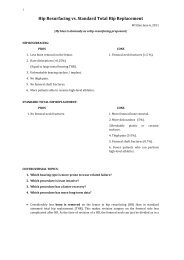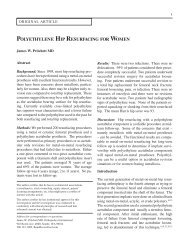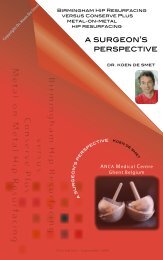Hip and Knee Arthroplasty - Surface Hippy Guide to Hip Resurfacing
Hip and Knee Arthroplasty - Surface Hippy Guide to Hip Resurfacing
Hip and Knee Arthroplasty - Surface Hippy Guide to Hip Resurfacing
Create successful ePaper yourself
Turn your PDF publications into a flip-book with our unique Google optimized e-Paper software.
EXECUTIVE SUMMARY<br />
This executive summary is intended <strong>to</strong> highlight<br />
some of the major findings of this year’s report.<br />
The information presented in this report has been<br />
reviewed prior <strong>to</strong> its release by members of the<br />
Australian Orthopaedic Association <strong>Arthroplasty</strong><br />
Society at a two day workshop held on 2 nd <strong>and</strong><br />
3 rd August 2008. The surgeons were invited <strong>to</strong><br />
provide feedback, comment <strong>and</strong> assist in<br />
determining the information that should be<br />
presented.<br />
The major purpose of the Australian Orthopaedic<br />
Association National Joint Replacement Registry<br />
(AOANJRR) Annual Report is <strong>to</strong> provide the most<br />
up <strong>to</strong> date information on the outcome of hip <strong>and</strong><br />
knee joint replacement surgery in Australia. The<br />
value of the information presented in the annual<br />
report is enhanced each year as a consequence<br />
of longer follow up time <strong>and</strong> the increasing<br />
number of procedures available for analysis.<br />
The format of the report is largely unchanged<br />
from previous years with the exception of the<br />
analysis of data provided by State <strong>and</strong> Terri<strong>to</strong>ry<br />
Health Departments. This information is<br />
presented as a supplementary report which is<br />
available on the Registry website<br />
www.aoa.org.au/jointregistry_pub.asp. As in<br />
previous years comprehensive demographic<br />
information on hip <strong>and</strong> knee replacement is also<br />
available on the Registry website.<br />
In November 2007, the Registry formally<br />
commenced data collection on additional<br />
arthroplasty procedures; these include shoulder,<br />
elbow, wrist, ankle <strong>and</strong> spinal disc replacement.<br />
Demographic data on these additional joint<br />
replacements is presented in a separate report<br />
also available on the Registry website.<br />
The number of hip <strong>and</strong> knee replacements<br />
undertaken each year continues <strong>to</strong> increase.<br />
Analysis of state <strong>and</strong> terri<strong>to</strong>ry health department<br />
data indicates an overall increase of 2.1% in hip<br />
<strong>and</strong> knee replacement for the period 1 st July<br />
2006 <strong>to</strong> 30 th June 2007 (hips 2.9% <strong>and</strong> knees<br />
1.4%) from the previous financial year. In<br />
addition, most procedures were undertaken in<br />
private hospitals (61%).<br />
There continues <strong>to</strong> be a changing pattern in the<br />
use of the different partial hip replacement<br />
categories previously reported by the Registry.<br />
The declining use of the Austin Moore type<br />
prostheses <strong>and</strong> increasing use of unipolar<br />
modular prostheses is again evident in 2007.<br />
Although the Austin Moore type prostheses<br />
remains the most used for arthroplasty<br />
management of fractured neck of femur, its use<br />
has halved in the last five years.<br />
The Registry has previously identified that<br />
revision rates of primary partial hip replacement<br />
are significantly affected by the category of<br />
prosthesis used, age at time of surgery <strong>and</strong> the<br />
method of fixation. Updated data on these three<br />
fac<strong>to</strong>rs are again presented in this report. The<br />
use of unipolar modular <strong>and</strong> bipolar procedures is<br />
associated with fewer revision procedures <strong>and</strong><br />
the use of cement fixation for these prostheses<br />
further reduces the risk of revision. Data on the<br />
outcome of using conventional <strong>to</strong>tal hip<br />
replacement for the management of fractured<br />
neck of femur are presented for the first time in<br />
the general hip section of this report.<br />
The use of <strong>to</strong>tal resurfacing hip replacement has<br />
declined for the second year. Presented again are<br />
the fac<strong>to</strong>rs affecting the outcome of <strong>to</strong>tal<br />
resurfacing procedures, these include primary<br />
diagnosis, type of prosthesis used, gender <strong>and</strong><br />
age. Patients having a <strong>to</strong>tal resurfacing for<br />
osteoarthritis are revised less frequently than<br />
patients with developmental dysplasia of the hip<br />
<strong>and</strong> avascular necrosis. Females have a<br />
significantly higher rate of revision <strong>and</strong> the risk of<br />
revision increases with age. Males also have an<br />
age related risk of revision which becomes<br />
significantly higher after the age of 65 years.<br />
This year the Registry is reporting an additional<br />
fac<strong>to</strong>r that significantly affects the outcome of<br />
resurfacing hip replacement, the size of the<br />
femoral head component. There is an inverse<br />
relationship between risk of revision <strong>and</strong> size of<br />
the femoral head component. This relationship is<br />
true for both males <strong>and</strong> females, <strong>and</strong> appears <strong>to</strong><br />
be the major cause for the difference in risk of<br />
revision between gender as previously reported.<br />
Increased revision with increasing age <strong>and</strong> the<br />
relationship <strong>to</strong> femoral component head size<br />
indicate that both bone volume <strong>and</strong> quality are<br />
fac<strong>to</strong>rs that may impact on the outcome of this<br />
procedure. The ASR <strong>and</strong> the Durom prostheses<br />
continue <strong>to</strong> be associated with an increased risk<br />
of revision.<br />
The use of primary conventional <strong>to</strong>tal hip is<br />
increasing not only in terms of absolute numbers<br />
but also as a proportion of all primary <strong>to</strong>tal hip<br />
procedures. In 2007 the number of new femoral<br />
<strong>and</strong> acetabular prostheses combinations reported<br />
<strong>to</strong> the Registry also increased, with a further 128<br />
new combinations recorded. For the first time<br />
the Registry is reporting the outcome of<br />
conventional hip replacement related <strong>to</strong> primary<br />
1






